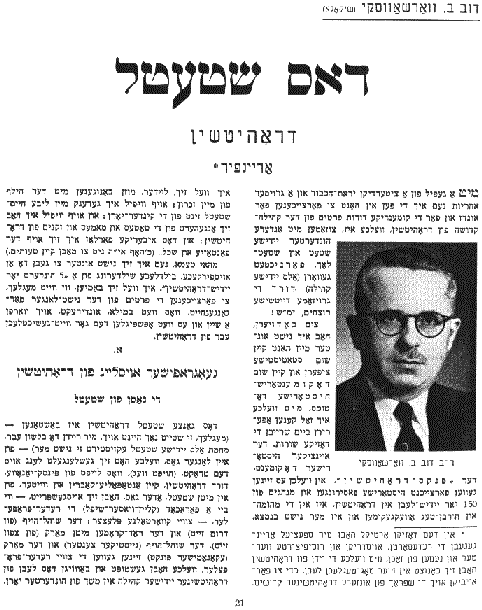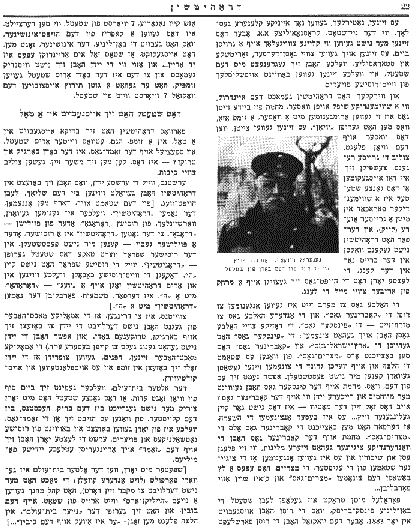Previous Page
|
Next Page

The Shtetl
Dov B. Warshavsky (Chicago)
[
Page 21
]
[Photo:] Rabbi Dov. B. Warshavsky
Drohitchin
Introduction
With a feeling of great awe and responsibility, l take my pen in hand to record
for our generation and for future generations information about the holy
community of Drohitchin, which was destroyed by the cruel German murderers, may
their names be erased, together with the communities of hundreds of other
Jewish towns and villages.
Unfortunately, I have no statistics or historical documentation available to
refer to while writing these lines.
Pinkas Drohitchin [Drohitchin Record Book]
, the only historical document describing the events and customs of 150 years
of Jewish life in Drohitchin, disappeared during the period of turmoil and
extermination, and has never been found. Unfortunately, I will have to be
satisfied with relying on what I remember about my beloved hometown since
childhood, and what I heard from the adults and elders of Drohitchin. I have to
rely on my imagination and common sense for the rest and, with God's help, hope
I don't make any errors.
For this reason I am not writing a comprehensive history of the last five
hundred years of Drohitchin. I will make every effort to describe the recent
past, which will thereby indirectly shed light on the more distant past of
Drohitchin.
I
Geographical Layout of Drohitchin
The entire shtetl of Drohitchin comprised (It's possible that it still exists
today, however, I speak of the town in the past tense because as a Jewish town
it no longer exists) one long street that winded along the highway running
through Drohitichin from Pinsk-Yanov to Antopolia-Kobrin and beyond. Two
residential areas fanned out from the center of the shtetl, or street, like
propellers on a small steamship: the synagogue courtyard (on the south) and the
row of stores (on the north). The synagogue courtyard (the spiritual center)
and the market (the economic center) were the two propellers that drove and
occupied the life of the Drohitchin Jewish
community for hundreds of years.
 [
Page 22
]
[
Page 22
]
There were, of course, other smaller streets such as New Town, Krasna Ulitsa
[Red Street], etc., but these were no more than small branches on a large tree.
There were also two one-street villages, Zaritchke and Starasilia which
bordered the shtetI and which were inhabited exclusively by White Russian
peasants.
[Photo:] General Minkov, the noble landowner who owned the shtetl.
Drohitchin actually resembled a ship floating on water because it was
surrounded by a body of water, a marsh called "Vion." There were
times when, because of driving rain, the water of the Vion would rise; the
result was that the entire town turned into a steamship floating on a lake.
Therefore, the town of Drohitchin could only expand lengthwise. In later years,
the main street extended to a length of over two miles.
Half of the street on the west end was called Kobriner Street, and the other
half, Pinsker Street. These two half streets also had other names: Pinsker
Street was called "Land of Israel Street," and Kobriner Street was
called "Egypt Street." No one knows for sure how these nicknames
originated, or who created them. Could it have originated from the fact that
more well-bred and wealthy Jews lived on Pinsker Street than on Kobriner
Street? If that was the reason, then it isn't a joke. I prefer to accept the
hypothesis that Kobriner Street was called Egypt Street because it was on
Kobriner Street that the wandering gypsies had their small taverns, where they
would eat and get drunk; it was commonly believed that the gypsies were
descendants of the ancient Egyptians. Some joker invented the nickname
"Egypt Street," and the name remained ever since.
Parallel to the highway next to the shtetl was the Pinsk-Brisk railway line
built by the Russians in 1883. However, the Russians removed the train station,
and placed it in Nagoria, 7 verst [approx. 5.5 miles: 1 verst =3,500 feet] from
Drohitchin. People said that this move was a whim of the chief engineer who
built the railway line, and who had expected the town would give him "a
little something." Since the Jews pretended not to know anything about it,
and because the soil around town was swampy, the engineer had an excuse to
build the station 7 verst from Drohitchin.
The Shtetl was built in a Valley
Why was Drohitchin built right in a valley, in marshlands, even though further
out of town, and especially on the sand street, the ground was mountainous and
dry? This was probably for two reasons.
First, because the first Jews who settled in Drohitchin wanted to live next to
the dirt road near the main road. (It can also probably be assumed that the
name "Drohitchin" was taken from the Russian "Doroga" or
from the Polish "Droga." It is unclear whether the name Drohitchin
has a Russian or Polish root. In Russian, the shtetl was called
"Drogitchin" because there is no "h" sound in Russian. The
White Russian peasants who live in and around Drohitchin pronounce the word
"doroha" with an "h", and therefore the name remained
Drohitchin with an “h.")
Secondly, the early local authorities apparently didn't allow the Jews to
settle on mountainous, dry land (and perhaps the Jews didn't have enough money
to buy better land.) The authorities were seemingly satisfied that Jews settle
on marshland and develop and cultivate it.
The old cemetery located at the end of the Vion attests to the fact that years
ago the whole town didn't reach the bridge, but only extended as far as the
church, where the sand street started, and which for years was inhabited by
Russian officials and peasants. Only in the latter period did a few Jewish
families also tread onto the "sand."
(Years later, when the old cemetery was full, or according to other sources,
when the authorities no longer allowed burials there, the community dedicated a
new cemetery far from town, on the Bubin [presumably a river] and called it the
New Cemetery. In jest people would say "he is off on the Bubin.")
Previous Page
|
Next Page
This material is made available by JewishGen, Inc.
and the Yizkor Book Project for the purpose of
fulfilling our
mission of disseminating information about the Holocaust and
destroyed Jewish communities.
This material may not be copied,
sold or bartered without JewishGen, Inc.'s permission. Rights may be
reserved by the copyright holder.
JewishGen, Inc. makes no representations regarding the accuracy of
the translation. The reader may wish to refer to the original material
for verification.
JewishGen is not responsible for inaccuracies or omissions in the original work and cannot rewrite or edit the text to correct inaccuracies and/or omissions.
Our mission is to produce a translation of the original work and we cannot verify the accuracy of statements or alter facts cited.
 Drogichin, Belarus
Drogichin, Belarus
 Yizkor Book Project
Yizkor Book Project
 JewishGen Home Page
JewishGen Home Page
Yizkor Book Director, Lance Ackerfeld
This web page created by Lance Ackerfeld
Copyright © 1999-2024 by JewishGen, Inc.
Updated 3 Dec 2001 by LA


 [
Page 22
]
[
Page 22
]
 Drogichin, Belarus
Drogichin, Belarus
 Yizkor Book Project
Yizkor Book Project
 JewishGen Home Page
JewishGen Home Page